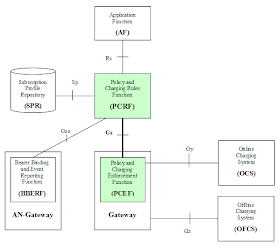Last two articles was about Offline and Online charging interfaces. So now, after we know "how the things are are going" in charging domain, it's a good time to describe how UEs are able to being charged for services they receive.
Always it's good to start with a high level abstract picture, but not today.
Being honest, today I'm a little bit lazy and just don't want to draw network architecture myself. You can easily find that on Google image search engine.
Information below are part of 3GPP TS 23.401, I just copied them. Below is everything you need to know about Network Attach procedure in LTE with many references.
UE needs to register with the network to receive services that require registration. This registration is called Network Attachment. The always on IP connectivity for UE is enabled by establishing a default EPS bearer during Network Attachment procedure. Predefined PCC rules most common set in PGW will be applied for default bearer. Attach procedure may trigger one or multiple Dedicated Bearer Establishment procedures to establish dedicated EPS bearer for that UE.
During the Initial Attach procedure the Mobile Equipment Identity is obtained from the UE. The MME operator may check the Mobile Equipment Identity with EIR. At least in roaming situations, the MME should pass the ME Identity to the HSS, and, if a PGW outside of the VPLMN (Visited PLMN), should pass the ME Identity to the PGW.
The E-UTRAN Initial Attach procedure is used for Emergency Attach by UEs that need to perform emergency service but cannot gain normal services from the network. These UEs are in limited service state (more about this in 3GPP TS 23.122). Also UEs that had attached for normal services and do not have emergency bearers established and are camped on a cell in limited service state shall initiate the Attach procedures indicating that the attach is to receive emergency services. UEs that camp normally on a cell, i.e. UEs that are not in limited service state, should initiate normal initial attach when they are not already attached and shall initiate the UE Requested PDN Connectivity procedure to receive emergency EPS bearer services.
Being honest, today I'm a little bit lazy and just don't want to draw network architecture myself. You can easily find that on Google image search engine.
Information below are part of 3GPP TS 23.401, I just copied them. Below is everything you need to know about Network Attach procedure in LTE with many references.
UE needs to register with the network to receive services that require registration. This registration is called Network Attachment. The always on IP connectivity for UE is enabled by establishing a default EPS bearer during Network Attachment procedure. Predefined PCC rules most common set in PGW will be applied for default bearer. Attach procedure may trigger one or multiple Dedicated Bearer Establishment procedures to establish dedicated EPS bearer for that UE.
During the Initial Attach procedure the Mobile Equipment Identity is obtained from the UE. The MME operator may check the Mobile Equipment Identity with EIR. At least in roaming situations, the MME should pass the ME Identity to the HSS, and, if a PGW outside of the VPLMN (Visited PLMN), should pass the ME Identity to the PGW.
The E-UTRAN Initial Attach procedure is used for Emergency Attach by UEs that need to perform emergency service but cannot gain normal services from the network. These UEs are in limited service state (more about this in 3GPP TS 23.122). Also UEs that had attached for normal services and do not have emergency bearers established and are camped on a cell in limited service state shall initiate the Attach procedures indicating that the attach is to receive emergency services. UEs that camp normally on a cell, i.e. UEs that are not in limited service state, should initiate normal initial attach when they are not already attached and shall initiate the UE Requested PDN Connectivity procedure to receive emergency EPS bearer services.




